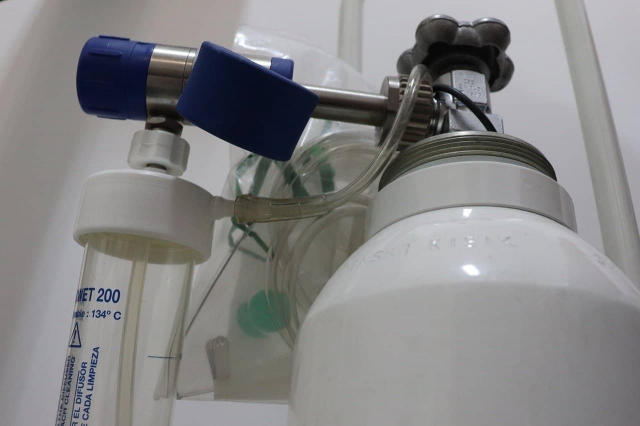Childhood asthma manifests as attacks. If an attack lasts and gets worse, it is an exacerbation. Between asthma attacks, breathing is normal. The doctor identifies and diagnoses the disease upon a physical examination and respiratory tests. Skin tests may be necessary to look for an allergic cause.
1. Childhood asthma; definition
Asthma is a chronic inflammatory disease of the airways, especially the bronchi. It is characterized by repetitive and intense episodes of difficulty breathing.
Due to the inflammation, the bronchi are swollen and produce thick secretions (mucus), which partially close the airways. Besides, the muscles in the bronchi that contract (bronchospasm) make it more difficult to breathe because air cannot flow freely through the lungs.
There are two types of asthma: episodic asthma and persistent asthma.
Episodic asthma affects children from 1 to 5 years old. The symptoms then appear for a few days, to disappear after appropriate treatment, and then reappear a little later with the next upper respiratory tract infection. This type of asthma usually goes away by school age.
Persistent asthma characterized by frequent symptoms; it can develop during early childhood but appears more often during the school period. It can persist for a person's entire life.
2. Childhood asthma; Asthma triggers
What is the cause of childhood asthma?
For unknown reasons, children with asthma are sensitive to certain stimuli (triggers) that do not affect children without asthma. Children with asthma may have a genetic profile that makes them more sensitive to react to certain triggers. Most asthmatic children also have parents and siblings or other loved ones with asthma, which shows that genes play an important role in asthma.
There are many potential stimuli, and the majority of children respond to only some of them. In some children, no specific trigger can be apparent.
The response to all stimuli is similar; certain cells in the airways release chemicals. These substances:
- Cause inflammation and swelling of the airways.
- Stimulate the contraction of muscle cells in the walls of the airways.
- Increase the production of mucus in the airways.
Each of these reactions contributes to the sudden narrowing of the airways (asthma attack). In most children, the airways return to normal between attacks. Repeated stimulation of the airways by these chemicals causes hypersecretion of mucus, causes loss of cells that line the airways, and swelling of muscle cells in their walls.
3. Childhood asthma symptoms
Asthma may only appear at certain times or be present all year round. The symptoms appear more or less intensely;
3.1 Childhood asthma attack, when the child experiences difficulty breathing due to various environmental, infectious, etc.
Symptoms of an asthma attack: One or more of these symptoms may appear in a child's asthma attack:
- Respiratory discomfort that occurs quickly
- A feeling of tightness in the chest
- A dry cough (fits)
- Wheezing.
Note: in children, these attacks are more frequent at night and upon waking (in the morning).
3.2 Exacerbation, when a crisis lasts and worsens.
Symptoms of the exacerbation
When these respiratory symptoms persist for several hours or even several days, despite the repeated intake of crisis treatment, one speaks of an exacerbation.
The exacerbation can appear suddenly or gradually and get worse quickly. And this, even in a child with well-controlled asthma.
3.3 Severe acute asthma: caused by major obstruction of the airways.
Symptoms of acute asthma
Severe acute asthma is an exacerbation that does not respond to treatment or of unusual severity. An asthma attack becomes a medical emergency when the child experiences the following symptoms:
- Great difficulty in breathing (chest or ribs sink with each breath)
- Blue lips and nails
- Dilation of the nostrils
- Difficulty speaking or walking
- Confusion or loss of consciousness.
In this case, call the emergency.
3.4 Spasmodic cough: In children, other symptoms are considered equivalents of asthma. This is the case with spasmodic cough, which manifests itself in episodes of dry coughs. They often occur:
- At the end of the night
- When the child laughs
- During annoyances and emotions
- When he stops the effort
- When there is a change of weather.
3.5 Exercise asthma: We speak of exercise asthma when an attack occurs during physical exercise or only a few minutes afterward.
Symptoms of exercise-induced asthma: The child has one or more symptoms:
- He is short of breath (abnormally)
- He coughs (often in a fit)
- He feels tightness of breath or chest pain
- His breathing becomes wheezy.
Related: Childhood Stress, difficult to spot, often underestimated
4. Childhood asthma treatment
As a first step, it is useful to act on all the factors favoring asthma attacks. In addition, there are 2 types of complementary drug treatments for asthma: treatment of asthma attacks, which relieves symptoms, and the disease-basic treatment, which treats inflammation of the bronchi.
4.1 Treatment of an asthma attack
The treatment of an asthma attack uses inhaled medications called "short-acting bronchodilators" (BDCA). They are prescribed by the doctor according to the age of the child but also his lifestyle. They help to dilate the bronchi to facilitate the passage of air and thus immediately relieve the attack's symptoms.
As a precaution, all children with asthma should carry a bronchodilator inhaler.
It is also necessary to know what to do when your child has an attack. To know:
make him sit down and loosen his clothes
encourage him to calm down and breathe slowly
give him his attack's treatment (repeat if necessary, according to the doctor's advice).
4.2 The basic treatment
In children, asthma is most often intermittent, especially in small children. But, a basic treatment is, despite everything, often necessary to avoid the aggravation. This type of treatment aims at treating the inflammation of the bronchi, and the patient should take it every day. He can appeal:
- To inhaled corticosteroids
- Long-acting bronchodilators (such as inhaled formoterol or salmeterol)
- Anti-leukotrienes (oral montelukast)
- Antihistamines or desensitization (in case of allergies)
5. Childhood asthma; How to prevent?
In general, breastfed babies have fewer allergies and asthma, but no confirmation is about the protective effect of breastfeeding.
Avoid exposing your child to second-hand smoke. It is also best to stop smoking, ideally before pregnancy.
Avoid places with high air pollution as much as possible.
Keep the house clean and mold-free.
Place a dust mite cover on the mattress of your child's bed.
Limit the number of doggies in your child's room and on their bed.
Try to avoid allergens that trigger asthma attacks in your child.
Get your whole family vaccinated against the flu every fall.
6. Does childhood asthma go away?
Asthma is a chronic disease. Its development takes place over several years and often throughout life. The attacks alternate with periods of calm of varying lengths, during which the disease does not manifest itself and can sometimes appear cured. However, even in the absence of symptoms, a person with asthma still has great sensitivity to the bronchi and will need to be vigilant in certain circumstances: viral infection, high exposure to allergens, fog, pollution, etc.
Some asthmatics see their symptoms decrease, sometimes disappear at least for several years. This is sometimes the case during the teenage years. Thirty to 50% of children with asthma no longer have any manifestations at puberty. It seems that children with mild asthma are more likely to see it disappear in adolescence than those with moderate or severe asthma, and especially, it seems if they have received appropriate treatment that protected their bronchi. However, it is rare for asthma to go away permanently. The frequency of relapses in adulthood is far from negligible.
In asthma caused by an allergy to a substance that is easy to identify, removing the allergen can make the disease symptoms go away completely. This is the case with asthma caused, for example, by domestic animals or green plants, such as ficus.
- Eight montessori activities to entertain children in containment
- Children’s emotional blackmail; a confession of parents’ weakness
- Educational psychologist job; how to become an educational psychologist?
Originally published on Live Positively.






